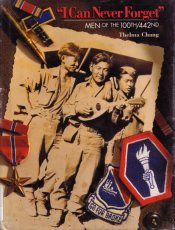
I Can Never Forget: Men of the 100th/442nd

Thelma Chang, 1991
This is one of the books about the Japanese-Americans who fought for the US in World War II, despite the fact that their parents and other loved ones were in internment camps in the US.
Like the other books on the topic, this is a very good book, very interesting. I will only point out some highlights from the book.
The groups the men served in were the US Army's 100th Infantry Battalion, the 442nd Regimental Combat Team, the Military Intelligence Service, and the 1399th Engineer Construction battalion (the 370th Engineer Battalion formed the nucleus of this group).
The first two groups ended up fighting in Europe, and were the most decorated units of their size in US Army history.
The 1399th was in Hawaii, building roads, bridges, airfields, barracks, etc. During the early part of the war, while the men worked, they were kept under armed guard. In other words, soldiers in the US military were being guarded by soldiers in the US military. How would it make you feel if you were trying to do something for your country, and you had to do it while you were being guarded by armed men, simply because your parents were Japanese?
The 100th and the 442nd became one unified group in June, 1944. The 100th became the first battalion of the 442nd, but they were still allowed to keep their own designation. The groups served in Italy and France, and acquired over 18.000 individual decorations for bravery, a Congressional Medal of Honor, and 52 Distinguished Service Crosses.
This was not done with their paying a very heavy price, however. The 100th/442nd lost about two-thirds of their men in the fighting. In one review, the division commander wondered why there were so few men assembled, and he ws told that the men there were all that were left of the units.
They were the objects of hatred and discrimination while in the US, training, though. Some white businessmen wanted all the Japanese in Hawaii removed to the mainland internment camps, which was really something that was not feasible and would have dealt a major economic blow to Hawaii if it owouldh ave been done.
The book talks about Hawaii just after the attack on Pearl Harbor. On the 7th, the Governor of Hawaii placed the area under martial law (Hawaii was a territory and not a state at the time). He also suspended the right of habeas corpus, which was a person's right under the law to protection from illegal imprisonment. Lieutenant General Walter Short proclaimed himself “military governor” at the same time. He suppressed civil courts and put things under military rule, which mean that even misdemeanors would be tried in provost courts, presided over by Army officers, who decided punishment without reference to federal or local statues. That lasted for three years.
Japanese fishing fleets were impounded. Hawaiians were urged to report any meetings of Japanese. The persons of Japanese ancestry were prohibited from travel or changing residences. They could not enter certain security areas, and all this even included Japanese-Americans working for the Military Intelligence Service.
How about the fear of persons of Japanese ancestry spying for Japan? From 1942 through 1944, 18 were charged with spying for Japan. All 18 were white.
In early 1942, the War Department pushed for the removal of all soldiers of Japanese ancestry from active service. By spring of 1942, a General Emmons wanted all Japanese-American officers and men in the 298th and 299th Regiments put into a Hawaiian Provisional battalion and then sent to the mainland.
No Japanese-American officer was allowed to head a rifle company.
When the nisei were moved to the mainland, there were problems with nisei that were from the mainland. Those from Hawaii and those from the mainland didn't get along at first, the Hawaiians being sort of a rowdy, but close-knit group, the mainlanders being more reserved and more individualistic. If someone needed some money for something, he would just ask and someone else would give him the money, but mainlanders didn't do that type of thing. There were even fights between the two groups from time to time.
The nisei soldiers also had some difficulty when they were sent to the South for training, as they were not ready for the intense black/white segregation of the south. At first, they didn't even know what water fountains to drink from; those marked White, or those marked Colored (although they were later told to use the White fountains.)
It is interesting that the book uses the term “concentration camp” for the internment camp at Jerome, Arkansas.
Main Index
Japan main page
Japanese-American Internment Camps index page
Japan and World War II index page
|